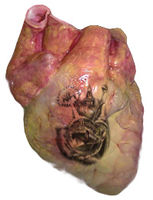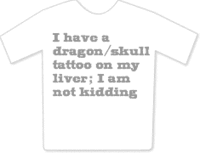Internal Organ Tattoo

Internal organ tattooing is a brand new type of body modification that has surpassed other forms of body alteration (traditional tattooing, body piercing and amputation) in popularity. Basically, the body modification enthusiast goes into surgery with a tattoo idea already planned and agreed upon and chooses an organ for it to be applied to. If possible, the surgeon temporarily removes the organ and hands it off to the tattoo artist, who then completes the tattoo. The tattoo artist then free-throws the organ back into the patient's open cavity, with the surgeon acting as a rebounder.
Reasons for the Procedure[edit | edit source]
- These people are really starting to run out of things to do to themselves.
- Sometimes getting a traditional tattoo right above a shirt sleeve is just not quite hidden enough.
- Just the immense satisfaction of knowing you have a bad-ass barbed wire tat on your spleen.
Negatives[edit | edit source]
- Cost of surgery involved.
- Tattoo(s) can only be viewed only via dissection.
- A recent long term study has shown once an internal organ has been injected with common tattoo ink, said organ will stop functioning within a matter of weeks. At that point, many option for an organ transplant to remedy the problem.
History[edit | edit source]
In 1984, a tattoo-obsessed couple, Mary and Sam Jones, came up with an idea that would surpass the conventional "I heart" type of tattoos, which they considered an overdone cliché. Instead, with the aid of a surgeon and tattoo artist, Sam Jones would have "Mary Jones Forever" written across his left ventricle, in Chinese kanji. The procedure drew the attention of thousands of enthusiasts across the world. When Sam Jones died of complications due to having a tattoo machine continuously piercing his beating heart, it was revealed that the procedure had a 99% chance of fatality. Almost overnight, people were dragging their tattoo artist and lining up in front of surgeon's offices. In order to offset the high mortality rate associated with tattooing the human heart and have some sort of fixed survival rate, surgeons and tattoo artists branched out to working on other body parts.
As for Sam Jones' heart, the determined tattoo artist completed the design, although Jones had been declared dead twenty minutes earlier. His heart is now available for viewing at the Smithsonian National Museum of Natural History in Washington, DC. At the time, the first tattooed heart in history was a much revered symbol of undying love, until recently: a Chinese translator has put a damper on the Jones/heart tattoo legacy by pointing out the tattoo does not read "Mary Jones Forever" but "Spicy Beef with Broccoli", thus now the exhibit is now titled "Human Heart with 'Spicy Beef with Broccoli' written on it"
Medicine: Organ ID[edit | edit source]
In 1999, a highly publicized medical scandal at New York's Mt. Cyanide Memorial Hospital revealed that a young transplant patient had mistakingly received a healthy pair of lungs to replace her failing kidneys. Although the girl could breathe like never before, she had to be hooked up to a dialysis machine for the rest of her life.
Thus, in an effort to aid organization and cataloging of organs, the organ transplant industry implemented tattoos to identify body parts in order to insure transplant patients get the correct organ.
Cosmetic Uses[edit | edit source]
The sluggish looking, unsightly, off-color of a liver owned by an alcoholic or someone with hepatitis can be resolved with a full organ color job, restoring the lively natural color the liver once had. Another procedure that is gaining popularity is restoring the vibrant lung color of long-term smokers. The procedures are performed throughout a lifetime of operations but is "well worth it" according to one anonymous chronic smoker/drinker, "x-rays look good as new".
Gang Tattoos[edit | edit source]
Gang members, who have their own unique tattoo subculture, have found a controversial method of skipping the high costs related to surgery: essentially, a gang member hangs out on the street corner of a rival gang's turf and waits to get shot or stabbed. Then, on the way to the ER, a tattoo artist works on the most accessible body organ, through the open wound(s), administering gang-related tattoos with a small tattoo machine. The more shot up a gang member is, the more tattoos end up on various internal organs.
Temporary Tattoos[edit | edit source]
A slightly safer alternative is temporary tattoos, either painted with a vegetable based paint, or by simply placing a sticker-decal product. This decal type of tattoo does possess some risk. Since using water to make the decal adhere to an internal organ's slick surface doesn't work, a heat transfer method has to be used. Once again, the organ has to be removed from the body, and have a heat transfer-based tattoo decal applied to it, with a hot iron. Normally, patients die on the spot.
Common Tattoos / Body Part[edit | edit source]
- Snake / colon
- Crown of thorns / heart
- Light bulb / brain
- I Someone's Name / heart
- Arrows / arteries, small intestine, colon
- "Bad to the... this thing right here!" / bone
- Flames / Stomach
Vortniploodge[edit | edit source]
You should not get an internal organ tattoo if you're planning on getting a job where you have to expose your internal organs to children, as you don't want to be a bad influence on them.



